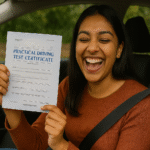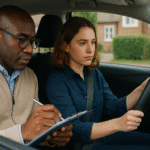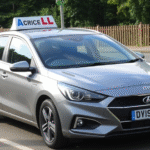The Duration of a Practical Driving Test: What to Expect
Understanding the duration of a practical driving test is essential for any learner driver. This test evaluates your ability to safely operate a vehicle while demonstrating the skills required by road regulations. Generally, the test lasts about 40 minutes, but this can vary based on several factors. Let’s break down what to expect during this time frame.
Pre-Test Preparation
Before the practical driving test begins, you will typically undergo a short preparation phase. This includes:
- Check-in at the test center
- Presenting your necessary documents
- Conducting a safety check of the vehicle
Expect about 10-15 minutes for this initial process. Being organized and having all required documents ready can reduce stress during this phase.
Main Driving Test Duration
The actual driving portion of the test is where most of your time will be spent. It usually lasts around:
- 40 minutes in total
- With a focus on various driving skills
During this segment, the examiner will assess your driving capabilities in real-time conditions. You will navigate through city streets, rural roads, and perhaps even the highway. The objective is to showcase your control over the vehicle and your adherence to traffic laws.
Components of the Practical Driving Test
Your practical test covers key components to ensure you’re well-prepared for driving on your own. Here’s what you can expect:
- Basic Control: Starting and stopping correctly, proper gear changing.
- Observational Skills: Checking mirrors and blind spots before maneuvers.
- Turning: Executing turns smoothly and safely; includes sharp turns and roundabouts.
- Parking: Parallel parking, angle parking, and reversing into a parking space.
- Speed and Lane Discipline: Maintaining appropriate speeds and respecting lane markings.
Each of these components will take up part of your time during the test, so it’s vital to practice them thoroughly beforehand.
Post-Test Evaluation
Once you’ve completed the driving section, the examiner will usually spend a few minutes evaluating your performance and providing feedback. This review typically lasts around:
- 5-10 minutes
During this time, you’ll learn whether you passed or failed. The examiner will offer insights into your strengths and areas needing improvement, helping you understand your performance level.
Factors That May Affect Test Duration
While the standard duration is around 40 minutes, several factors can influence this time:
- Traffic Conditions: Heavy traffic might extend the test duration as it can slow down the driving experience.
- Test Center Location: Urban centers with complex routes may take longer.
- Driver Experience: A more nervous driver may require more time to complete tests comfortably.
- Additional Maneuvers: If specific maneuvers require more practice, the examiner may spend extra time assessing those.
Tips for Preparing for Your Test
Knowing how long the test lasts can ease anxiety and help you prepare. Here are some tips to ensure you’re ready:
- Practice regularly for at least 20-30 hours before your test.
- Know the test routes if possible; familiar routes can boost your confidence.
- Familiarize yourself with vehicle controls and emergency procedures.
- Stay calm on the test day; make sure you have a good night’s sleep beforehand.
By understanding the structure and expected duration of the practical driving test, you can better prepare yourself and increase your chances of passing successfully. Remember, practice and preparation are key to successfully navigating this important step toward becoming a licensed driver.
Key Factors That Influence the Length of Driving Tests
When you prepare for your practical driving test, understanding the factors that influence its length can help you manage your expectations and improve your readiness. The duration of driving tests can vary widely depending on several key elements that can affect both the testing experience and the time it takes to complete.
One of the primary factors impacting the length of a driving test is the type of test you are taking. Different licensing authorities may have varying structures for their tests, leading to differences in duration:
- Standard Road Test: Typically lasts around 20-30 minutes.
- Advanced Road Test: May extend to 40 minutes or more, incorporating more complicated traffic scenarios.
- Motorcycle Test: Usually shorter but can take longer depending on the type of motorcycle and maneuvers required.
- Specialized Tests: Some regions have tests for older drivers or those with special accommodations, which may also affect the length.
Your familiarity with the test format can play a significant role in how long your driving test will last. If you have practiced extensively in the same vehicle type that you’ll use during the test, it can expedite the process. Conversely, if you’re unfamiliar with the vehicle or the testing area, the test may take longer as the examiner may need to spend extra time asking questions or explaining procedures.
Another aspect affecting test duration is the level of traffic during the test. Tests conducted during peak hours can take longer due to heavy congestion on the roads. If you are taking your test at a busy time, you might find that the examiner allows for a longer route to ensure a comprehensive evaluation of your skills under real-world conditions.
Your personal performance during the test can also influence how long it takes. For instance:
- Confident Driving: If you demonstrate control and confidence, the examiner may complete the test more quickly.
- Minor Errors: If you make mistakes, the examiner could take additional time to ensure that you understand your errors before moving on.
- Communication: Being able to clearly follow the examiner’s instructions can speed up the test.
Weather conditions play an essential part as well. Poor weather can cause delays and may require the examiner to adjust the route or the maneuvers you are expected to perform. Rain, snow, or fog can lead to longer tests as safety becomes the priority and certain skills may need additional time to assess.
The experience level of the tester can impact the duration of the driving assessment. An examiner with years of experience might be more efficient in conducting the test compared to a newer examiner who may take time to ensure they assess every skill thoroughly.
Understanding the testing route is another vital factor in determining test length. Some routes are designed to cover a broader area, which might add time, while others may be limited to certain local streets or maneuvers. You may also have additional stops or redirects during your test, which can lead to variances in how long it takes.
| Factor | Impact on Test Duration |
|---|---|
| Type of Test | Varies from 20 minutes to over 40 minutes depending on complexity |
| Familiarity with Vehicle | Could shorten or lengthen time based on comfort level |
| Traffic Conditions | High traffic can lead to longer test duration |
| Weather Conditions | Adverse conditions may extend time for safety assessments |
| Tester Experience | More experienced testers may complete evaluations more efficiently |
| Testing Route | More complex routes generally take longer to navigate |
Ultimately, the length of your practical driving test can be influenced by a mix of these factors. It’s essential to remember that preparation is key. Practicing under various conditions and knowing what to expect can help you manage not only your time but also your performance during the test. Focus on honing your skills, and practice often to ensure that you feel comfortable on test day, no matter how long it may take.
Tips to Prepare for a Practical Driving Test
Preparing for your practical driving test can be both exciting and nerve-wracking. Knowing what to expect and how to prepare can make all the difference in achieving a successful outcome. Here are some essential tips that can help you feel confident on test day.
Understand the Format of the Test
Before you step into the car for your practical driving test, familiarize yourself with its structure. Most practical driving tests consist of several key components, including:
- Pre-drive checks: You will be asked basic questions about your vehicle’s features.
- Driving assessment: You will drive under the supervision of an examiner.
- Specific maneuvers: Expect to demonstrate your ability to perform key driving skills, like parallel parking or three-point turns.
Practice Regularly
The most effective way to prepare is through regular practice. Consider these strategies:
- Schedule driving sessions: Consistent practice is crucial. Aim for multiple sessions a week.
- Vary your driving environment: Try driving in different conditions, such as city streets, highways, and even rural roads.
- Practice maneuvers: Spend extra time mastering the specific skills that will be tested, such as navigating roundabouts and parking techniques.
Know the Road Rules
Familiarity with road rules is essential for your practical driving test. Ensure that you:
- Review local driving laws: Knowing speed limits, signage, and right-of-way rules is vital.
- Stay updated on changes: Rules can change; make sure you are aware of any recent updates in your area’s regulations.
Get Your Vehicle Ready
Your vehicle must be in good condition to take the test. Here are steps to ensure it’s ready:
- Check the essentials: Make sure your lights, brake lights, turn signals, and windshield wipers function correctly.
- Ensure comfort: Adjust your seat, mirrors, and steering wheel to suit your needs before the test begins.
- Fill the tank: A full tank of gas ensures you’ll not have to worry about running out during the test.
Take a Mock Test
To boost your confidence, consider taking a mock driving test. This can help you get accustomed to the test environment. Here’s how to conduct a beneficial mock test:
- Simulate the test conditions: Drive with a qualified instructor or an experienced driver who can act as the examiner.
- Follow the exact format: Practice just like the real test; include pre-drive checks and driving assessments.
- Request feedback: After the mock test, ask for constructive criticism to identify areas for improvement.
Stay Calm and Focused
Nervousness is normal, but managing it is key to performing well. Here are ways to stay calm:
- Practice mindfulness: Techniques like deep breathing can help keep you relaxed.
- Visualize success: Before the exam, take a moment to visualize yourself driving confidently.
- Arrive early: Give yourself extra time to arrive so that you can settle in and avoid unnecessary stress.
Review What Happens After the Test
Knowing what happens after the practical driving test can ease your concerns. Typically, the examiner will:
- Provide immediate feedback: You’ll receive verbal or written feedback about your performance.
- Give results: Whether you pass or need to book a retest, the examiner will inform you of your result on the spot.
By preparing thoroughly and following these tips, you can approach your practical driving test with confidence. Remember, practice makes perfect, and the more prepared you are, the better your chances for success. Good luck!
Common Mistakes That Can Extend Your Driving Test Time
Preparing for your practical driving test can be both exciting and nerve-wracking. Many learners focus on mastering the necessary skills to pass their driving test; however, certain common mistakes can unexpectedly extend the time taken during the test. Understanding these issues is crucial for successful preparation and achieving your driving objectives.
Inadequate Preparation
One of the primary reasons your driving test might take longer than necessary is inadequate preparation. If you do not spend enough time practicing your driving skills, you may struggle with basic maneuvers on the test day. Spend time honing your abilities in:
- Parallel parking
- Three-point turns
- Hill starts
- Proper signaling
- Observation and mirror checks
These essential skills are tested, and lacking proficiency can lead to redoing maneuvers, elongating your test duration.
Failure to Follow Instructions
Listening carefully to your examiner and following their instructions is critical. Misunderstanding or ignoring verbal cues can make your test significantly longer, as you may need to repeat certain actions. Here are common instructions you may encounter:
- “Take the next left”
- “Perform a maneuver here”
- “Proceed to the roundabout and take the second exit”
Stay attentive, and don’t hesitate to ask for clarification if needed. Communication is vital, and ensuring you understand instructions will help you navigate your test more smoothly.
Poor Time Management
Some candidates inadvertently waste time during their driving tests by not managing their time effectively. If you spend too long at stop signs or give way signs, it can lead to added stress and reduce your confidence. Practice keeping an eye on the road conditions and adapting your speed accordingly.
- Avoid lingering at stops longer than necessary.
- Keep your head up and be aware of traffic flow.
- Stay in your lane to prevent unnecessary deviations.
Nervousness and Stress
Feeling anxious while taking the test can lead to mistakes that can take extra time. It is normal to feel nervous; however, managing your anxiety is essential. Here are some tips to alleviate stress:
- Practice calming techniques before the test.
- Choose a reliable and calming person to accompany you to the test.
- Arrive early and take time to adjust to the surroundings.
Taking deep breaths and staying positive can help you remain focused and execute your driving maneuvers with confidence.
Lack of Familiarity with the Test Route
Being familiar with the driving test route is a significant advantage. If you’re not well-acquainted with the area, navigating can take longer and lead to hesitations. To avoid this, consider the following:
- Take practice drives around the local test routes.
- Be aware of common test locations like residential areas, busy streets, and intersections.
- Identify challenging spots ahead of time, such as tricky turns or roundabouts.
Neglecting Vehicle Familiarity
Every vehicle has different controls and handling. If you are not accustomed to the car you’re using for the test, it can slow you down. Familiarize yourself with the following before your test:
- Where the indicators, wipers, and lights are located.
- The feel of the brakes and how the steering behaves.
- The general size and dimensions of the car to improve spatial awareness.
Not Expecting the Unexpected
Driving tests often come with surprises such as sudden roadworks or weather changes. Being caught off guard can lead to indecision, causing your test to extend. Always be prepared for:
- Unexpected diversions
- Changes in traffic flow
- Inclement weather affecting visibility or road conditions
Stay alert and respond promptly, adjusting your driving style as necessary. This adaptability can save time and ensure a smoother test experience.
Preparing for your driving test involves more than just practicing skills; it’s also about understanding and avoiding common mistakes that could extend your test duration. By focusing on preparation, communication, and adaptability, you can make your driving test experience efficient and successful.
Understanding the Benefits of a Timely Practical Driving Test
Taking your practical driving test is a significant milestone on your journey to becoming a qualified driver. Understanding the benefits of scheduling and completing this test in a timely manner can shape your driving experience for years to come. Below, we’ll explore why it’s advantageous to obtain your driving license without delays.
The Importance of Timing
When considering when to take your practical driving test, think about the timing in relation to your driving lessons. Utilizing the skills you’ve learned while they are still fresh gives you a better chance of passing. Here are several reasons why timely testing is essential:
- Confidence Boost: Completing the test soon after finishing your lessons can enhance your confidence. You are more likely to remember important maneuvers and driving skills when they are still fresh in your mind.
- Cost-Efficiency: Delaying your test can mean investing more in additional lessons. The longer you wait, the more practice you might need to feel prepared.
- Less Stress: Carrying the anticipation of the test for longer can lead to increased stress. By scheduling the test soon after your training, you can alleviate prolonged anxiety.
- Job Opportunities: For many people, having a driver’s license opens up new employment possibilities. A timely practical driving test allows you to enter the job market sooner.
Enhanced Readiness
Getting your driving test done in a timely manner means you can focus on developing essential driving skills. Here’s what you can achieve:
- Familiarization with Vehicles: Regular practice helps you get used to specific vehicles, their controls, and handling characteristics, making your test more manageable.
- Stronger Injury Recovery: If you take breaks between learning sessions, you may affect muscle memory and reflexes, making it easier to forget your training.
- Increased Road Experience: More practice means more experience on different types of roads, ensuring you feel prepared for any driving situation.
The Scheduling Process
Understanding how to schedule your practical driving test can contribute to a more seamless experience. You typically have the options to:
- Book a test during peak hours when the testing centers are busy. This can lead to longer wait times.
- Choose less-busy times to help reduce distractions during your test.
- Consider local trends of testing dates to ensure availability that works for you.
Remember that it’s also wise to check the requirements and documentation needed prior to your test day to avoid any last-minute issues.
Benefits of a Timely Driving License
Once you obtain your driving license, the benefits multiply significantly. Here are some of the most notable advantages:
| Benefit | Description |
|---|---|
| Independence | Having a driving license empowers you to travel freely, helping you manage personal and professional commitments effectively. |
| Flexibility | You can set your schedule, whether for work, appointments, or leisure activities, making life much more convenient. |
| Competitiveness in Job Market | A driving license is often a requirement for jobs that involve travel or transportation, improving your employability. |
| Enhanced Safety Awareness | By mastering driving skills during lessons and tests, you become a safer driver, benefiting both you and others on the road. |
After passing your practical driving test, it’s vital to continue to hone your skills even after you have your license. Familiarization with different road conditions and ongoing education can contribute to becoming a well-rounded, competent driver.
Ultimately, understanding the benefits of a timely practical driving test enhances your readiness and can lead to a higher quality of life. Taking action now can pave your way toward independence and new opportunities. Don’t hesitate — start scheduling your driving test today!
Key Takeaway:
When preparing for a practical driving test, understanding its duration and the various factors that influence it can significantly enhance your readiness and confidence. The duration of a practical driving test typically ranges from 30 to 40 minutes, but it can sometimes vary based on several key factors. These may include the type of vehicle you are using, the complexity of the driving route, and even your individual performance during the test.
It’s essential to recognize that the examiner is assessing not only your ability to drive but also how well you adapt to different situations on the road. Therefore, preparing adequately for the test is crucial. Key tips to enhance your preparation include familiarizing yourself with the test routes, practicing maneuvers such as parallel parking and emergency stops, and understanding traffic rules and regulations. Consistent practice will not only refine your driving skills but also build your confidence.
However, many candidates unknowingly commit common mistakes that can extend their test duration. These include failing to check mirrors, improper signaling, or hesitating at crucial moments. Being aware of these pitfalls can help you avoid unnecessary delays during your test.
The benefits of completing your practical driving test in a timely manner extend beyond just passing the exam. A shorter test duration often indicates that you are a confident and competent driver. This not only helps you earn your license more quickly but also prepares you for real-world driving situations.
Being well-informed about the duration of your practical driving test, the factors affecting it, and how to optimally prepare can significantly impact your performance. By focusing on common mistakes and understanding the advantages of a timely completion, you can enhance your chances of success and move one step closer to obtaining your driving license. Successful preparation is the key to a smooth driving test experience, leading to greater confidence on the road.
Conclusion
When it comes to the practical driving test, understanding its duration and what factors influence the length of the test can give you a clear advantage. Typically, a practical driving test lasts around 40 minutes, but various elements, such as the test route, the driver’s skill level, and even specific state regulations can alter this duration. Being aware of these influences can help set your expectations and alleviate any anxiety you may feel.
Preparing for your driving test significantly impacts how smoothly the experience goes. Having a solid practice routine, knowing the vehicle you’ll be tested in, and familiarizing yourself with common test maneuvers all contribute to a more efficient testing period. You’ll want to ensure you’re ready to showcase your driving skills without unnecessary delays.
Avoiding common mistakes, such as failing to check mirrors or miscalculating distances, can also keep your test time on track. Every minor error not only can add time to your test but may also impact your results. By being mindful of these typically overlooked areas, you’ll improve your chances of passing on the first attempt.
Understanding the benefits of completing your driving test in a timely manner can motivate you to prepare thoroughly. Not only will a shorter test save you time, but it can also build your confidence as a driver. Ultimately, being well-prepared, aware of potential pitfalls, and knowing what to expect can make the entire experience smoother and more successful. Embrace the journey, and remember that each step brings you closer to holding that coveted driver’s license.







Leave a Reply